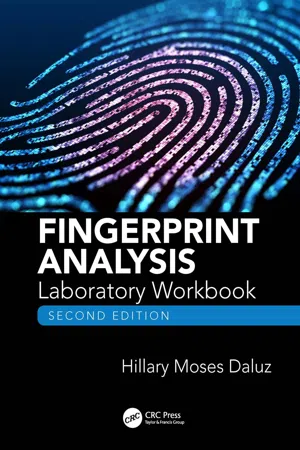
- 112 pages
- English
- ePUB (mobile friendly)
- Available on iOS & Android
Fingerprint Analysis Laboratory Workbook, Second Edition
About This Book
Fingerprint collection and analysis may be performed as part of many jobs, including crime scene technician, latent print examiner, criminalist, and lab supervisor. Regardless of one's specific background or role in the process, a knowledge of scientific practices is critical in handling and analyzing fingerprint evidence. The best way to understand the principles and concepts of any science learned in a classroom is to perform experiments.
The exercises in Fingerprint Analysis Laboratory Workbook, Second Edition address all aspects of fingerprint theory, investigation, processing, comparisons, and research. Designed specifically to parallel the Fundamentals of Fingerprint Analysis, Second Edition textbook, the laboratory exercises correspond with the textbook chapters, with exercise in the lab chapter putting into practice the concepts covered in the text chapter. Each lab follows the same format, beginning with the objectives of the experiment and providing the background information necessary to perform the experiment. This is followed by a list of required materials, the lab exercises, and post-lab questions for students to test what they've learned.
Many of the laboratory exercises may be completed either at home or in a laboratory setting. Exercises and photographs enhance the text, making it an ideal hands-on learning tool. New techniques and current practices added to the primary textbook have been included in this companion laboratory workbook to cover the latest in real-world application of fingerprint analysis science to practice.
Frequently asked questions
Information
Part I
Introduction to Fingerprints
Chapter 1
Introduction
Objectives
- Understand the concept of class and individual characteristics and how this applies to the science of fingerprint identification
- Identify the class and individual characteristics of fingerprints
1.1 Background
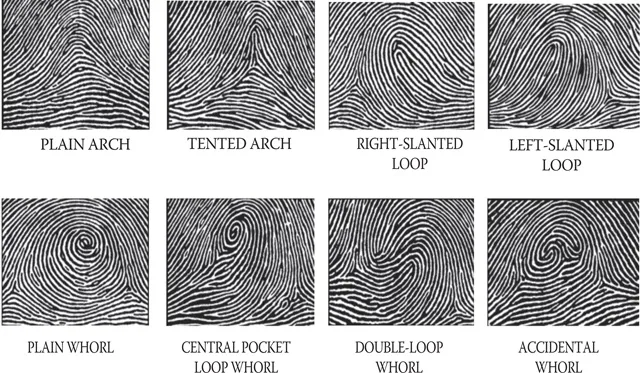
The eight fingerprint sub-pattern types: plain arch, tented arch, right-slanted loop, left-slanted loop, plain whorl, central pocket loop whorl, double-loop whorl, and accidental whorl.
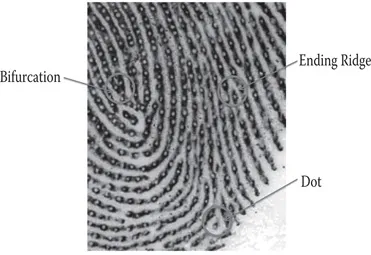
A bifurcation, dot, and ending ridge in a magnified portion of a fingerprint.
1.2 Materials
- Pen or pencil
- Figure 1.3
- Figure 1.4
1.3 Exercises
Part I: Class and Individual Characteristics
- Identify the class and individual characteristics for each type of forensic evidence listed in Figure 1.3.
Part II: Class Characteristics
- Identify all observable class characteristics of a classmate, friend, colleague, or spouse
- What are the individualizing characteristics associated with that individual?
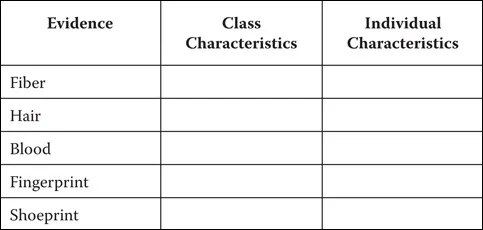
Part I: Class and Individual Characteristics—Identify the class and individual characteristics for each type of forensic evidence listed.
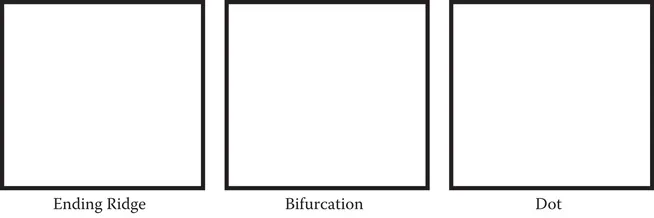
Part III: Individualizing Characteristics—minutiae: draw a bifurcation, ending ridge, and dot.
Part III: Individualizing Characteristics—Minutiae
- Draw the following minutiae in Figure 1.4:
- Bifurcation
- Ending ridge
- Dot
1.4 Post-Lab Questions
- Are fingerprint pattern types individual characteristics? Why or why not?
- What are the eight fingerprint sub-pattern types?
- What are the three types of minutiae found in fingerprints?
- Are minutiae class or individual characteristics? Why or why not?
- Besides narrowing the possible source...
Table of contents
- Cover
- Half Title
- Title Page
- Copyright Page
- Dedication
- Table of Contents
- List of Figures
- Preface
- Acknowledgments
- About the Author
- Part I Introduction to Fingerprints
- Part II Latent Print Development
- Part III Fingerprint Analysis